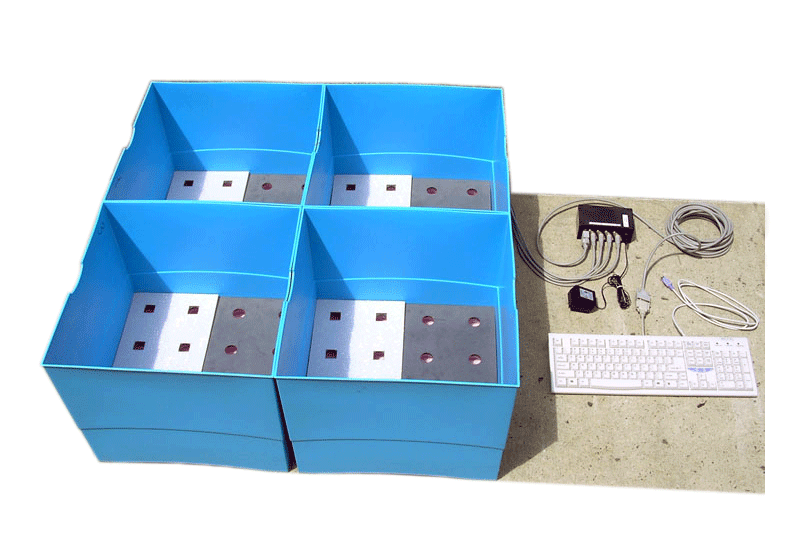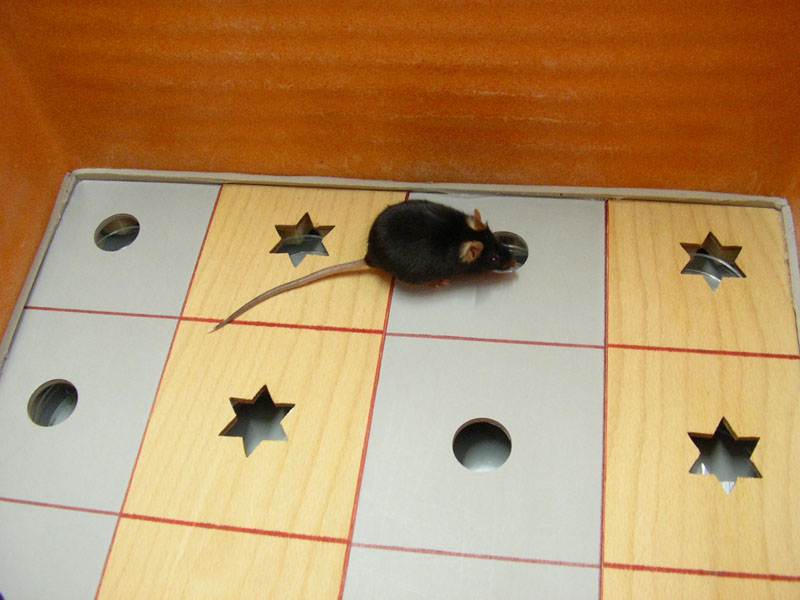
This system can be used as a classic 16-hole hole-board or it can be used with any known protocol of novel object recognition task. In our task a mouse can discriminate between holes in the floor with different shapes (round, square, 6-point star, etc.) and/or between different floor materials. In addition, this system works well for any olfactory discrimination.
 |
Technically, device is recording nosepoke activity with a help of infrared beams under the floor. Typical system consists of 4 independent chambers (about 16’’ x 16’’ each) and 4 mice can be tested simultaneously. There are two versions available. The first one is optimized for Noldus EthoVision (3.1 or any previous) and it is intended for use with Noldus video-tracking hardware and software for data acquisition and analysis. The second version is independent from Noldus EthoVision and it does not use video-tracking. |
|
 |
Our system has high discriminative power and it was verified using C57BL/6J, DBA/2J and B6D2F1 mice after standard and enriched housing conditions. Mice were taken from: Wolfer et al., Nature 432, 821-822 (2004). [Supplement 1, 2, 3] |
|
During the last 25 years Holeboard task has evolved from classic version with manual recording of mouse behavior towards modern computer-controlled system with infrared beams under the floor. Modern system can register duration of exploratory episodes to within 10 ms (using the same classic geometry with 16 holes (d = 25 mm) in the 40 × 40 cm arena, surrounded by vertical walls). In the classic Holeboard the single specific indicator of behavior was the number of nosepokes (for example, during 6-min session). In the modern setup it was discovered that two other indicators have better discriminative power: 1) “total exploration time” (this time is about 40-70 s for 6-min session) and, especially, 2) mean “nosepoke duration” (typical nosepoke duration is about 0.5-1.2 s). Contrary to straightforward logic, mean nosepoke duration can provide higher statistical significance than the number of nosepokes or total exploration time.
Video tracking is also useful for Holeboard task. It can not be used instead of nosepoke registration, but systems with simultaneous video tracking and infrared beams under the floor are available now. The best ones can video track 4 animals in 4 Holeboard units with concurrent registration of all nosepoke activity.
In addition to above-mentioned technical progress, there is significant progress in Holeboard protocols. Today after the application of a classic hole-board protocol during the first two days (for investigation of habituation) it is reasonable to apply at least one day of visual-tactile discrimination and at least one day of olfactory discrimination. During the visual-tactile discrimination test at least one hole of Holeboard is replaced by a hole with different shape [for example, circular hole is replaced by star-shaped hole], and/or the floor material, corresponding to at least one above-mentioned hole, is replaced by material which differs in color and/or surface texture; above-mentioned material can also have entirely different origin and/or production history [as, for example, plywood in comparison with polyvinyl chloride]. During olfactory discrimination test the unusual odor is placed under at least one hole of Holeboard [it can be, for example, Mint odor]. Usually during olfactory discrimination test the classic floor with 16 circular holes is used. There are publications with 4-hole Holeboard for olfactory discrimination, but the decrease in the number of holes leads to significant decrease in discriminative power (i.e. efficiency) of Holeboard test, at least in accordance with our observations. During both visual-tactile and olfactory discrimination we recommend to use equal numbers of new and old holes (e.g. 8 circular holes vs. 8 star-shaped holes and 8 holes without odor vs. 8 holes with Mint odor). Minimal modern protocol consists of 4 days: days 1 & 2 — classic Holeboard, day 3 — visual-tactile discrimination, day 4 — olfactory discrimination.
| Evolocus Holeboard |  |